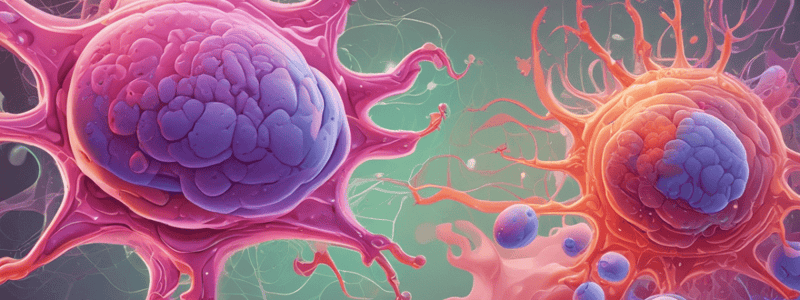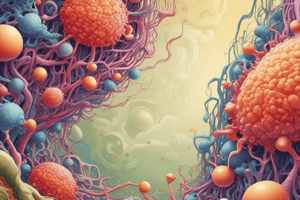Podcast
Questions and Answers
What is the role of G-protein (Gustducin) in Type II taste cells?
What is the role of G-protein (Gustducin) in Type II taste cells?
- It initiates the signal transduction process. (correct)
- It directly produces ATP for the cell.
- It acts as a secondary messenger only.
- It activates the neurotransmitter release.
Which statement best describes the Type III taste cell's signaling mechanism?
Which statement best describes the Type III taste cell's signaling mechanism?
- It relies on membrane depolarization to initiate neurotransmitter release.
- It transmits signals exclusively through gustducin.
- It directly binds to sweet, umami, or bitter ligands for activation.
- Calcium ions are released after activation, triggering ATP formation. (correct)
What occurs after the Type III taste cell is activated by its ligands?
What occurs after the Type III taste cell is activated by its ligands?
- The primary sensory neuron fires action potentials. (correct)
- A secondary messenger system becomes inactive.
- The cell remains unchanged until the next stimulus.
- Inhibition of neurotransmitter release happens immediately.
What is the consequence of signal transduction in Type II taste cells?
What is the consequence of signal transduction in Type II taste cells?
Which ligand types activate Type II taste cells?
Which ligand types activate Type II taste cells?
Flashcards are hidden until you start studying
Study Notes
Type II Taste Cell
- Responds to sweet, umami, or bitter substances.
- Utilizes G-protein Gustducin to initiate taste signaling.
- Employs G protein-coupled receptors (GPCRs) for ligand recognition and signal initiation.
- Following ligand binding, the cell undergoes depolarization, leading to a change in membrane potential.
Type III Taste Cell
- Activated by various ligands that interact with taste receptors.
- Triggers multiple intracellular signaling pathways upon activation.
- Calcium ions (Ca2+) released into the cytoplasm play a crucial role in cellular response, promoting exocytosis or ATP production.
- Release of neurotransmitters or ATP transmits signals to primary sensory neurons.
- Primary sensory neurons generate action potentials, relaying taste information to the brain for processing.
Studying That Suits You
Use AI to generate personalized quizzes and flashcards to suit your learning preferences.



